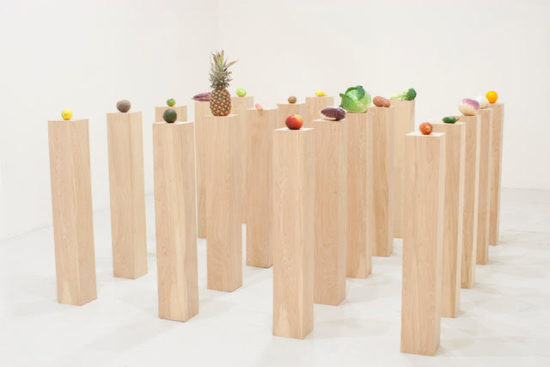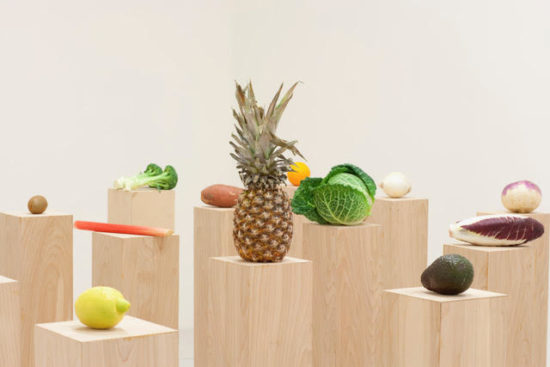This week’s contributing author, Natalie Reeder, is an undergraduate student at Northeastern University in Boston, Massachusetts pursuing a combined BA and MA in International Affairs & Spanish.
VoCA is pleased to present this blog post in conjunction with Associate Professor of Contemporary Art History, Gloria Sutton’s Spring 2020 Honors Seminar, The Art of Visual Intelligence at Northeastern University. This interdisciplinary course combines the powers of observation (formal description, visual data) with techniques of interpretation to sharpen perceptual awareness allowing students to develop compelling analysis of visual phenomena.
Throughout history, the aesthetic elements of food have been reproduced in art and culture, with images of staged meals appearing on a wide range of platforms from social media to blogs to paintings to billboards. Food is often accompanied by labels, whether they be menu descriptions, nutrition facts, or claims of sustainability and locality. In a nod to readymade artists like Marcel Duchamp, New York-based artist Darren Bader’s recent exhibition challenges our historical separations between aesthetic and utilitarian value by taking a utilitarian category, produce, and asking viewers to appreciate it not for its nutritional value or planetary impact, but for its aesthetic beauty.
Bader’s untitled exhibition, captioned fruits, vegetables; fruit and vegetable salad, was displayed from January 15 to February 17, 2020 at the Whitney Museum of American Art. His work removes all of the accoutrements that often accompany food—the captions, recipes, slogans, and labels of healthy, organic, and local—and instead challenges us to interact with a diverse array of fruits and vegetables in a manner focused more on the sculptural elements of the produce. This work draws focus to the natural shapes, colors, and scents of the selected produce, even as it decays. Instead of allowing complete decay, as it ripens, the produce is removed and prepared as salad to be consumed by visitors.

Darren Bader, fruits, vegetables; fruit and vegetable salad, dimensions variable. Image courtesy of the Artist and Andrew Kreps Gallery, New York.
The exhibition consists of 40 identical wooden pedestals where, following the artists’ instructions, Christie Mitchell, Senior Curatorial Assistant at the Whitney, along with a team of art handlers, sources produce from Chelsea Market and Fresh Direct. As this produce is sourced from grocery stores, instead of directly from farms, it has already been sorted and pre-selected to be the most pleasing and symmetrical fare. I believe that selecting produce in this manner goes against the goals of the exhibition in some ways as grocery stores typically only stock produce that consumers will buy. The pushback of companies like Imperfect Produce demonstrate that not all produce makes it to the grocery store shelves. Current food systems pressures in light of COVID-19 also underscore that not all grocery stores provide the same access to the produce Bader’s exhibit displays, even in the best of times. Individual access limitations and industry-wide elimination of imperfections are layers missing from Bader’s critical work. Bader successfully highlights the artistic elements of produce but fails to address regional and industry level inequalities.
Engaging with popular concerns about food waste, Bader includes an interactive portion of his exhibit where visitors are encouraged to try salad created from his art before it spoils. Using food in art is not new, but many artists like Joseph Beuys and Lee Bul allowed food to decay fully before it was removed from exhibitions, rather than removing the food before it becomes inedible. In Bader’s exhibition, the ripening produce is removed from the pedestals four times a week, chopped up, and mixed together in the museum’s Studio Café Kitchen, a process projected in the gallery, for visitors to consume. The produce is mixed together in one bowl, resulting in unusual flavor combinations like raw sweet potato with kiwi and avocado.1 This interactive portion of Bader’s work builds on that of other artists like Jennifer Rubell and Rirkrit Tiravanija, artists whose exhibitions have encouraged visitors to be a part of art making experience through eating food. This gives visitors the chance to leave their mark on the exhibition and walk away with a more visceral idea of the food-art being displayed.

Darren Bader, fruits, vegetables; fruit and vegetable salad, dimensions variable. Image courtesy of the Artist and Andrew Kreps Gallery, New York.
Just as Bader’s work challenges the ways in which we see food, it also confronts the ways in which we see and make meaning from art. His work is necessarily ephemeral, as the produce used as medium ripens and is consumed. At the same time that Bader embraces the impermanence of his material, he also embraces art as a concept instead of as a static and tangible object. Bader’s work demonstrates that art can be dynamic: the produce displayed and the resulting salad change daily due to the availability of produce and whims of the curators. As this work is not one that can be purchased and stored until it is ready to be displayed, Bader sold a certificate of authenticity to the Whitney which provided exhibition instructions. It specified that “the work consists of fruits and vegetables totaling any even number between twelve and infinity,” and emphasized the importance of variety.2
The value of Bader’s work in this exhibit was not due to its physical nature, just as the value of the headlining Miami Basel Banana by artist Maurizio Cattelan didn’t depend on what banana or even what fruit was taped to the wall. Instead, the interactions and conversations that the art inspires is what produces value. Bader embraces the decay of his work instead of fighting it, an approach that opposes historical conservation-focused mindsets of everyone from museums to curators to the artists themselves. This builds on a body of work by other artists’ using food as well as other ephemeral mediums including wax and ice. The progression of food decay brings with it smells, juices, mold, and other sensory demands in a way that is meant to make people take notice. Bader’s work counters this movement by halting decay and repurposing his work into an experience.
Bader’s work also tries to mitigate the waste of art creation, repurposing his materials into something else after their “shelf life” has been used up. Bader recycles his work into a new iteration that reduces waste and broadens the experience visitors have in the exhibition. The recycling of his work for other purposes is a model that could encourage creation of more sustainable and less environmentally impactful artworks in the future.
Sources:
- George, Cassidy. “I Ate the Worst Salad of My Life in the Name of Art.” The Cut. January 21, 2020. https://www.thecut.com/2020/01/i-ate-the-worst-salad-of-my-life-in-the-name-of-art.html
- Zara, Janelle. “A Brief History of Perishable Art: How Darren Bader’s Divisive Fruit Salad at the Whitney Fits Into a Ripe Tradition.” Artnet News. January 28, 2020. https://news.artnet.com/art-world/darren-bader-fruits-vegetables-food-art-1763388
